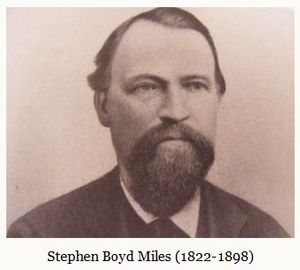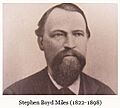Miles Ranch facts for kids
The Miles Ranch was one of the very first large ranches built west of the Missouri River. It was started in 1855 by Stephen Boyd Miles near Dawson, Nebraska. He received the land from the United States government because he agreed to transport mail, goods, and people between Independence, Missouri, and Salt Lake City, Utah.
The Ranch was perfectly located along the important Overland Trail. This made it the main base for Miles' big stagecoach business. Hundreds of horses and mules rested and recovered at the Ranch to keep the busy stagecoach lines running. The first crop grown there was hemp, which was used to make strong ropes.
The Miles Ranch was like a small city all by itself! It covered a huge area, as much as 42,000 acres, stretching across parts of Nebraska and Kansas. Many buildings were built on the Ranch, including several barns, a bunkhouse (where workers slept), silos for storing crops, and other houses. A clever water system was also created to provide water for everyone and everything on the Ranch. There was even a post office in the first simple house, along with a general store, a blacksmith shop, and a sawmill. Since it was a stagecoach stop, the Miles Ranch also offered a place for tired travelers to stay the night.
Long before Stephen Miles built his ranch, this land was home to different Native American tribes. The Pawnee and the Otoe tribes were among the first to live in the area. Later, the Sac and Fox, and the Iowa tribes arrived. After them came the Winnebago and the Sioux tribes.
Contents
The Amazing Barn
Stephen Miles built a truly special barn at the Ranch. It was a Pennsylvania-style bank barn, which means it was built into the side of a hill, allowing wagons to enter the upper level directly. This huge barn was made entirely from strong walnut wood, cut by hand right on the Ranch. The pieces were fitted together using a method called mortise and tenon, held with wooden pegs instead of nails! The large stones for the barn's foundation were cut from the banks of the nearby Nemaha River. This impressive building was finished sometime between 1855 and 1861 and was key to the S. B. Miles Stage Line operations.
In December 2012, this historic barn was officially added to the National Register of Historic Places by the United States Department of the Interior. The Nebraska State Historical Society called it the best example of its kind in Nebraska and said it was one of the oldest, if not the oldest, barns in the state.
Growing the Ranch Business
After the American Civil War ended in 1866, Miles won another contract to carry mail, this time to Texas. Around this period, he also started a big cattle ranching business. People in the eastern United States wanted more and more beef, so Miles saw a great opportunity. With the help of his two sons, Joseph and Samuel, Miles brought thousands of cattle all the way from Texas to the Miles Ranch. At this time, the Ranch might have covered as much as 42,000 acres and employed hundreds of people.
The Grand Mansion
The first house on the Miles Ranch was quite simple. But in 1867, a new, grand two-story home was built for the Miles family. This house was designed in a style called Anglo-American Mid-Atlantic I-house, which was popular back then. It had beautiful detailed woodwork, both inside and out, and a balanced, symmetrical design that showed the influence of the Greek Revival style.
Like the barn, the Miles mansion was built with hand-cut walnut beams and wooden pegs. The wood for the house was also harvested from the Ranch. Other building materials, like windows, doors, and roof shingles, were brought from St. Louis by steamboat to Rulo, Nebraska. From there, they were loaded onto wagons and driven to the Ranch. Once the house was finished, it was filled with fancy items like a piano and pieces of art.
In December 2012, the Miles Ranch mansion house was also added to the National Register of Historic Places. The Nebraska State Historical Society described the home as a "superlative example of a rare property." Together with the barn, the Miles Ranch is considered truly unique in Nebraska. There are no other places in the state with an 1860s rural home and an even older barn that are so well-preserved.
By the late 1800s, the Miles Ranch was very diverse. It produced over 75,000 bushels of corn and 17,500 bushels of wheat each year. About 300 acres were used for oats and 100 acres for barley. The Ranch also sold between 1,000 and 1,500 hogs every year. Additionally, 400 acres provided 1,500 tons of hay. The main types of cattle raised were Hereford, Shorthorn, and Angus.
The money earned from the Miles Ranch allowed Stephen Miles to successfully start other businesses, like banking. He became one of the wealthiest people in the West.
The Great Snow Winter
The winter of 1880-1881, known as the "Snow Winter," brought terrible blizzards to the prairies. The Miles Ranch was hit hard too. Heavy snow started falling in October and didn't melt until late spring. The deep snow and ice meant the cattle couldn't find grass to eat, and thousands of them died from hunger. They couldn't even reach the hay that the ranch hands had left for them.
Luckily, the Ranch was able to recover from the financial damage of the "Snow Winter." This was mainly because Stephen Miles had a lot of money saved and had invested in many different businesses. After that tough winter, Miles sold some of his large land holdings and focused more on his banking investments.
The Miles Will and Later Years
When Stephen Miles passed away in 1898, his estate became involved in a long legal fight. People argued over who should inherit his huge fortune. This famous case, known as the "Miles Will," lasted for 12 years! It even went to the Nebraska Supreme Court five times. In the end, the final decision favored Miles' oldest son, Joseph H. Miles.
After the long legal battle, the Miles Ranch had a good period of success. This was under the leadership of J.H. Miles' oldest son, Stephen, and the family's agent, William Schock. The Ranch did well partly because grain prices were higher and Europe needed more food during World War I. During this time, the Ranch's general manager was D.F. Harbaugh, who was a famous detective. Even though Harbaugh didn't have much ranching experience, he learned quickly. His presence and detective skills helped the Ranch feel secure during a difficult time.
By the mid-1920s, the Miles Ranch began to struggle. Farm prices dropped sharply because European farms started producing more food, and new machines made farming more efficient. Heavy debts also became a problem. By 1935, thousands of acres of Miles Ranch land had to be sold off to pay back banks.
During the mid-1920s and early 1930s, J.H. Miles' youngest son, Warren, took over managing the Ranch, which was short on money. The Great Depression and the Dust Bowl made things even harder. During this tough time, the Miles Ranch became known for hosting all-night, high-stakes poker games. Some stories say that as much as 1,000 acres of Miles Ranch land might have been lost in just one night of gambling! During the time of Prohibition (when alcohol was illegal), local stories say the Miles Ranch was the only place in Richardson County where alcohol was available. Things found at the Ranch also suggest that alcohol, possibly wine or hard cider, was being made there. There was a large orchard near the mansion house, so it's possible they even made stronger drinks.
During the Depression, the Miles Ranch's land holdings went from about 16,000 acres down to around 2,000 acres. In 1935, J.H. Miles' oldest son, Stephen, took over managing the much smaller Ranch again. The Ranch didn't fully recover until the end of World War II.
For the next 64 years, the Miles Ranch was successfully farmed by tenant farmers who paid a share of their crops as rent. Stephen left the Ranch to his two sons, Stephen III and Joe. Some of the families who farmed the land over the years included the Koelzer, Arnold, Van Winkle, Shaw, and Thompson families from Richardson County, Nebraska.
Even though Samuel Miles didn't inherit most of Stephen Miles' fortune, he did receive a good amount of money and some smaller parts of the Miles Ranch. In the 1950s, Samuel's son, Clarence Gillespie Miles, found a lot of oil on their land! The oil wells he discovered are still producing oil today, though they are no longer owned by the family.
The Miles Ranch stayed in the Miles Family until 1999 when it was sold. Since then, the property has had several different owners and was empty for a number of years. Much of the land that once belonged to the Miles Ranch has been bought by large farmers in the area.
In February 2011, the six acres that included the old mansion house, barn, and other buildings were bought by the Bruxellas Family. They have spent over five years carefully restoring and repairing the property, and these efforts are still continuing. Today, the Miles Ranch is a family-owned and operated micro-vineyard.
The ranch was officially added to the National Register of Historic Places in 2012.
The Miles Ranch Foundation was started in 2014. This foundation works to share the story of the pioneers who traveled through the Ranch. They do this by collecting and preserving old items and information. Their goal is to make sure that future generations can learn about the history of the Miles Ranch and its lasting legacy of being a sustainable place.
Images for kids



